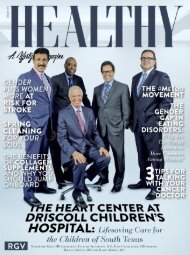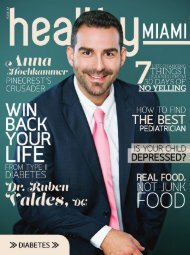Healthy RGV Issue 113
You also want an ePaper? Increase the reach of your titles
YUMPU automatically turns print PDFs into web optimized ePapers that Google loves.
HEALTHY LIFESTYLE · APRIL 2018<br />
BEYOND DRUGS:<br />
The Other Breakthroughs<br />
in Cancer Research<br />
We usually associate cancer<br />
research and clinical trials<br />
with new cancer medicine.<br />
But evidence-based<br />
cancer care goes far<br />
beyond providing drug therapies to patients.<br />
Exciting research developments that are<br />
unrelated to cancer medicines are improving<br />
patients’ outcomes and quality of life.<br />
Breakthroughs include technology to<br />
improve cancer screening, ways to minimize<br />
the side effects of cancer treatment, and<br />
tools to determine best approaches for<br />
treatment. We’re increasingly able to use<br />
and analyze data to customize cancer care<br />
for specific patients. Clinical research drives<br />
each of these non-medicine advancements.<br />
Better Prevention and Screening<br />
01 Research that helps identify causes<br />
and risk factors leads to better cancer<br />
prevention. Better screening and earlier<br />
detection enables physicians to treat cancer<br />
sooner with greater success. Research is<br />
underway to find better screening tools for a<br />
variety of cancers.<br />
One example of such research is already<br />
making a difference. Mammograms<br />
traditionally are the most reliable way to<br />
discover breast abnormalities. Traditional<br />
mammograms, however, are sometimes<br />
unable to identify concerning areas in<br />
women with dense breast tissue. Researchers<br />
developed a newer technology called 3-D<br />
mammography, which takes many lowdose<br />
X-rays to create a three-dimensional<br />
picture of the breast. Also called digital<br />
tomosynthesis, the procedure helps doctors<br />
locate and better examine suspicious areas<br />
in dense breast tissue beyond traditional<br />
mammograms.<br />
Reduced Side Effects from<br />
02 Cancer Treatment<br />
Chemotherapy is the most common form<br />
of cancer treatment. Unfortunately, the<br />
treatment sometimes has negative side<br />
effects, including nausea and hair loss.<br />
Reducing side effects can improve patients’<br />
quality of life. Many years ago, research that<br />
developed better nausea medications now<br />
has helped thousands of patients relieve<br />
symptoms of this side effect and spurred<br />
transferring most delivery of chemotherapy<br />
from a hospital to an outpatient setting,<br />
enabling patients to be more comfortable at<br />
home with their families.<br />
More recently, researchers developed a<br />
“cooling cap” to combat chemo-induced<br />
hair loss. The cooling cap reduces scalp<br />
temperature to reduce the blood flow to<br />
hair follicles before, during, and after chemo<br />
treatment, which helps prevent hair loss.<br />
Although currently FDA-approved for limited<br />
cancer types, research indicates that about<br />
half of patients who use a cooling cap will<br />
successfully retain their hair through chemo<br />
treatments.<br />
More Precise Radiation<br />
03 Treatment<br />
Most people know that radiation therapy<br />
often accompanies drug treatments such<br />
as chemotherapy, but many don’t realize<br />
that radiation therapy has ongoing clinical<br />
trials too. Such research has improved<br />
the precision of radiation beams to more<br />
exactly target tumors and minimize damage<br />
to surrounding tissues. Texas Oncology’s<br />
participation in the Radiation Therapy<br />
Oncology Group gives patients access to<br />
many promising radiation trials.<br />
Improved Patient Outcomes and<br />
04 Experiences<br />
Researchers comb mountains of data to<br />
discern the most effective treatments and<br />
patient experiences for specific types of<br />
cancer. That research, in turn, benefits<br />
many future patients. Texas Oncology<br />
participates in evidence-based pathways,<br />
which uses research and data to inform<br />
doctors which therapeutic interventions<br />
are most appropriate for each individual<br />
patient’s case. For example, we now can<br />
customize some treatments for breast<br />
cancer patients based on how patients with<br />
similar molecular profiling have responded to<br />
certain approaches. By treating patients with<br />
the right treatment at the right time, we can<br />
improve outcomes.<br />
Drug therapies will always be a vital part of<br />
cancer care. But thanks to new research and<br />
technology, cancer care continues to expand<br />
beyond drugs to improve outcomes and<br />
patient experiences.<br />
GUILLERMO LAZO, M.D.<br />
Guillermo Lazo, M.D., is a medical<br />
oncologist at Texas Oncology—<br />
McAllen, 1901 South 2nd Street, in<br />
McAllen, Texas.<br />
To learn more about exciting<br />
advancements in cancer treatment,<br />
visit www.TexasOncology.com<br />
or call 1-888-864-I CAN (4226).<br />
16 HEALTHY MAGAZINE
















